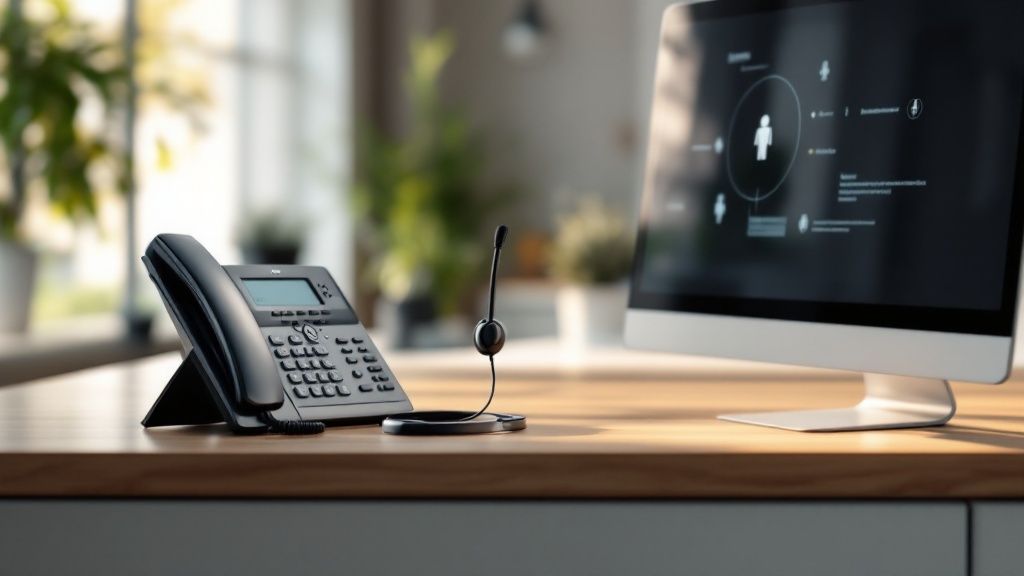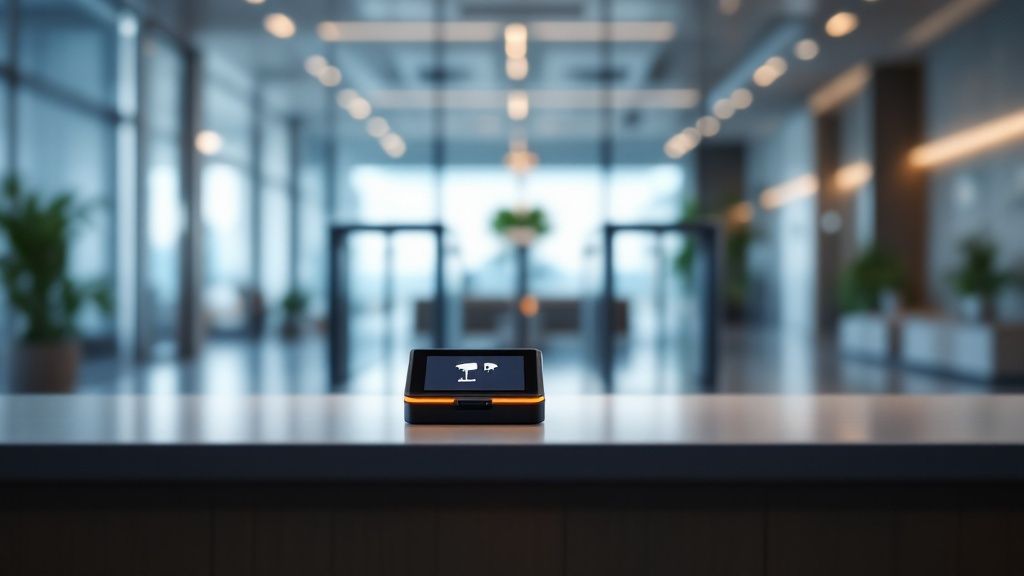The Evolving Role of the Modern Receptionist
This listicle outlines six core responsibilities of receptionist in 2025. Understanding these key duties is crucial for optimising your front-of-house operations and ensuring a professional, welcoming environment. Whether you're a mortgage broker, real estate agent, property manager, trades professional, or small business owner, this list provides valuable insights into the evolving role of the modern receptionist. Learn how effective reception management directly impacts client experience, streamlines daily tasks, and enhances overall business efficiency.
1. Managing Front Office Communications
As a core responsibility of a receptionist, managing front office communications is paramount to the smooth operation of any business, particularly for busy professionals like mortgage brokers, real estate agents, property managers, trades professionals, and small business owners in Australia. This involves being the first point of contact for all incoming communication streams, including phone calls, emails, and in-person inquiries. A receptionist expertly navigates these channels, efficiently routing calls to the appropriate departments, taking accurate messages, screening calls when necessary, and responding to general inquiries, all while maintaining a professional and welcoming demeanour. Effective communication management ensures that clients, partners, and internal staff can connect with the right people efficiently, creating a positive and productive environment.

This multifaceted role requires proficiency in several key features: multi-channel communication management, operating call routing systems, taking and distributing messages, handling email correspondence, and screening visitors. Imagine a busy real estate office in Sydney. The receptionist might be answering calls about property listings while simultaneously responding to emails regarding rental applications and greeting prospective clients walking through the door. This highlights the importance of multitasking and prioritization in this role. For businesses dealing with high volumes of communication, Learn more about Managing Front Office Communications to see how a virtual receptionist service can help.
This diligent management of communications creates a polished first impression for the organisation. It centralises the communication flow, preventing interruptions to other staff members who can then focus on their core tasks, and ensures that no communication is missed. For a mortgage broker, this could mean the difference between securing a deal and losing a client due to a missed call or delayed response.
However, the role is not without its challenges. Managing high volumes of communication, especially during peak hours, can be overwhelming. It requires constant attention, efficient multitasking, and the ability to handle potentially difficult or upset callers. System downtime, like an internet outage, can also present significant challenges, highlighting the importance of having backup systems in place.
Here are some actionable tips to excel at managing front office communications:
- Develop a standardized greeting script: This ensures consistency and professionalism.
- Create a comprehensive internal directory: Quick access to contact information streamlines call routing.
- Utilize call management software effectively: Features like call forwarding and voicemail can significantly enhance efficiency.
- Take clear, detailed messages: Include the caller's name, contact number, time of call, and the purpose of their call.
- Prioritize urgent communications: Implement a system for flagging urgent calls and emails for immediate attention.
- Implement a reliable backup system: Have procedures in place for handling communications during system outages or when you're away from the desk.
Managing front office communications deserves its place on this list because it forms the backbone of efficient business operations. By effectively handling all incoming and outgoing communications, the receptionist plays a crucial role in maintaining a professional image, ensuring smooth workflows, and ultimately contributing to the success of the organisation.
2. Visitor Reception and Management
A key responsibility of a receptionist is visitor reception and management. This encompasses the entire process of welcoming guests and visitors to the premises, ensuring they feel acknowledged and directed appropriately. This involves a range of tasks, from the initial greeting and welcome, through to assisting them with their needs and ensuring they adhere to company procedures. Effective visitor management contributes directly to a positive first impression of the business, reflecting professionalism and efficiency. It's a critical component of the overall smooth operation of any organization, particularly for those in client-facing industries like mortgage broking, real estate, and property management.

This aspect of the receptionist role involves several crucial features: implementing visitor check-in processes, enforcing security protocols (such as requiring identification and issuing visitor badges/passes), providing directional assistance within the building, and managing waiting areas to ensure they are comfortable and presentable. These processes enhance organizational security by tracking who is in the building, which is particularly important for trades professionals and small business owners.
Examples of successful implementation: Imagine a busy real estate office in Sydney. The receptionist greets prospective buyers with a warm smile, checks them in using a digital visitor management system, and notifies the agent of their arrival. Or consider a property manager in Melbourne, whose receptionist efficiently manages contractor access, ensuring they sign in and out while adhering to site safety regulations. This demonstrates the adaptability of effective visitor management across various professional contexts.
Tips for Effective Visitor Reception and Management:
- Maintain a warm but professional demeanor: A friendly greeting sets the tone for a positive visitor experience.
- Learn to recognize regular visitors: Addressing regular visitors by name adds a personal touch.
- Have visitor materials prepared in advance: Brochures, forms, or other relevant materials readily available minimise wait times.
- Develop protocols for handling unexpected or unauthorized visitors: A clear procedure ensures consistent and appropriate responses.
- Maintain an organized visitor log system: This provides a valuable record for security and administrative purposes.
Pros:
- Enhances organizational security: Knowing who is on the premises at any given time is crucial for safety and security.
- Creates a positive first impression for visitors: A welcoming reception area reflects positively on the business.
- Provides structure to visitor flow: Streamlined processes ensure visitors are directed efficiently.
- Helps track who is in the building: Essential for emergency situations and general security management.
Cons:
- May create bottlenecks during busy periods: High visitor volume can challenge even the most efficient receptionist.
- Can be challenging when dealing with unauthorized visitors: Requires tact and adherence to established protocols.
- Requires balancing hospitality with security concerns: Maintaining a welcoming atmosphere while upholding security procedures requires careful balance.
Visitor reception and management is an essential responsibility of a receptionist and deserves its place on this list because it directly impacts the efficiency, security, and overall image of the business. By effectively managing visitors, receptionists contribute significantly to a professional and welcoming environment, making a positive impression on clients, contractors, and other visitors. This is vital for professionals such as mortgage brokers, real estate agents, property managers, small business owners, and trades professionals who regularly interact with clients and other stakeholders in their workplaces. Implementing the tips provided can significantly improve visitor management processes, leading to a smoother, more secure, and more positive experience for everyone.
3. Administrative Support and Office Management
A core aspect of a receptionist's responsibilities of receptionist often extends beyond the front desk and into the realm of administrative support and office management. This involves a diverse range of tasks essential for ensuring smooth daily operations and maintaining an organized and efficient work environment. These duties can include managing calendars and scheduling appointments, coordinating the use of meeting rooms, ordering and managing office supplies, handling incoming and outgoing mail and courier services, maintaining filing systems (both physical and digital), and providing basic technical support for office equipment. This element of the role is crucial for businesses of all sizes, especially for busy professionals like mortgage brokers, real estate agents, property managers, small business owners, and trades professionals who rely on streamlined processes to focus on their core responsibilities.

Features like efficient calendar management, meeting room coordination, and a well-maintained office supply inventory contribute significantly to a productive workspace. For example, a real estate agent's receptionist might manage property viewing schedules and ensure that all necessary documents are prepared for potential buyers. In a trades professional's office, the receptionist might coordinate technician schedules, order parts, and manage invoices. Proper document management and proficient operation of office equipment, such as printers and scanners, are also critical for minimizing disruptions and delays.
This administrative support frees up valuable time for other team members to focus on their specialized tasks. A property manager, for instance, can rely on their receptionist to handle tenant inquiries and schedule maintenance appointments, allowing them to focus on property management tasks. Centralizing these routine administrative functions with the receptionist also provides consistency in office processes, ensuring that tasks are handled uniformly and efficiently.
However, taking on administrative tasks can also present some challenges. It can sometimes distract from primary reception duties, such as greeting clients and answering phones. It also requires the receptionist to have a broad knowledge of many systems and processes. This expansion of responsibilities can often lead to a workload imbalance and responsibilities creeping beyond the initial job description. Receptionists require a diverse skillset to manage their various duties effectively. For a deeper dive into the core competencies of similar roles, you might find this resource helpful: key responsibilities and skills.
To mitigate these potential downsides, receptionists can develop efficient systems for routine tasks, such as creating checklists for recurring responsibilities and setting aside specific times for administrative duties. Cross-training with other administrative staff can also be beneficial for sharing the workload and ensuring continuity. Documenting processes is another vital step, allowing for easy handover or training of new staff members. By implementing these strategies, receptionists can effectively manage the multifaceted responsibilities of receptionist associated with administrative support and office management, contributing significantly to the overall efficiency and productivity of the workplace.
4. Information Distribution and Communication Liaison
A crucial responsibility of receptionists, often overlooked, is their role as an information distribution and communication liaison. They act as the central nervous system of an organisation, ensuring the smooth flow of information between staff, visitors, and different departments. This involves disseminating important updates, announcements, and messages, acting as a knowledgeable point of contact for both internal and external queries. This responsibility demands staying informed about company events, staff whereabouts, emergency procedures, and general organizational knowledge, making them an invaluable asset in any business environment.

For businesses in the AU region, particularly for mortgage brokers, real estate agents, property managers, small business owners, and trades professionals, this centralised communication hub becomes even more critical. Imagine a busy real estate office. The receptionist fields calls about property viewings, manages agent schedules, distributes information about new listings, and answers client queries. This streamlined communication avoids confusion, ensures clients receive timely updates, and allows agents to focus on their core tasks. Similarly, in a trade business, the receptionist can relay urgent job updates, schedule appointments, and manage communication with clients and suppliers, minimizing delays and improving overall efficiency.
This role encompasses several key features: distributing internal announcements (e.g., policy changes, meeting reminders), tracking staff locations, managing event information (e.g., conferences, training sessions), understanding and communicating emergency procedures, and acting as a repository of organizational knowledge. The benefits are numerous: creating a centralized information source, ensuring consistent messaging, reducing misinformation, and assisting visitors in navigating the complexities of the organisation. For instance, a property manager's receptionist can quickly inform tenants about building maintenance schedules, minimizing disruptions and improving tenant satisfaction.
However, this role also comes with its challenges. It requires constantly updating information, which can be stressful due to the responsibility for accuracy. The sheer volume of information can be overwhelming at times. Furthermore, receptionists must maintain confidentiality while being informative, a delicate balancing act that requires discretion and professionalism. For example, a mortgage broker's receptionist must handle sensitive financial information with utmost care and adhere to strict privacy guidelines.
To succeed in this role, receptionists can implement several helpful tips. Creating an information management system (digital or physical), verifying information before distributing it, developing relationships with key departmental contacts, maintaining organized reference materials, and requesting regular briefings on important organizational changes can significantly improve efficiency and accuracy. You can learn more about Information Distribution and Communication Liaison. Think of the streamlined front desk information systems popularized by hotel chains like Marriott and Hilton – these provide excellent examples of successful implementation.
This role deserves a prominent place on the list of receptionist responsibilities because it directly impacts organizational efficiency, client satisfaction, and internal communication. By effectively managing information flow, the receptionist plays a vital role in creating a smooth, informed, and well-connected work environment.
5. Maintaining Office Security and Safety
A key responsibility of a receptionist, and one that deserves a prominent place on this list, is maintaining office security and safety. This multifaceted role places the receptionist at the forefront of protecting personnel and property, making them a vital component of any secure and efficient workplace. In Australia, where workplace health and safety (WHS) is paramount, a competent receptionist contributes significantly to compliance and a safe working environment.
The receptionist acts as the first line of defence, controlling access to the premises and ensuring only authorised individuals enter. This involves a range of tasks such as:
- Access Control Management: Operating and monitoring security systems, issuing access badges, and managing keys.
- Security System Monitoring: Keeping an eye on CCTV cameras, alarm systems, and other security technologies. This includes responding to alerts and reporting any suspicious activity.
- Visitor Verification: Greeting visitors, verifying their identity and purpose, and signing them in and out. This creates a clear record of who is on the premises at any given time.
- Maintaining Visitor Logs: Accurate record-keeping is crucial for security audits and investigations. Digital visitor management systems are becoming increasingly popular and can streamline this process.
- Emergency Procedure Implementation: In the event of a fire, medical emergency, security breach, or other critical incidents, the receptionist is often the first responder. They must be well-versed in emergency procedures, including evacuation plans, first aid protocols, and contacting emergency services.
- Incident Reporting: Documenting security breaches, incidents, and near misses is vital for identifying patterns, improving security measures, and complying with WHS regulations.
Examples of Successful Implementation:
- A receptionist at a mortgage broker's office manages secure access to client files and financial information, ensuring confidentiality and compliance with privacy regulations.
- In a busy real estate agency, the receptionist verifies the identity of tradespeople before granting access to properties for maintenance or repairs.
- At a large property management firm, the receptionist monitors multiple entry points and CCTV cameras, ensuring the safety of both tenants and staff.
Pros:
- Enhances workplace safety: A vigilant receptionist can deter potential threats and ensure a safer environment for everyone.
- Prevents unauthorised access: Strict access control protocols protect sensitive information and valuable assets.
- Provides quick response to emergencies: The receptionist’s familiarity with emergency procedures enables a rapid and coordinated response.
- Creates accountability through visitor tracking: Detailed visitor logs help identify individuals in case of incidents or security breaches.
Cons:
- Places significant responsibility on reception staff: This role requires training, vigilance, and the ability to handle pressure.
- Requires making sometimes difficult judgment calls: Receptionists may face situations requiring quick thinking and decisive action.
- Necessitates balancing security with hospitality: Maintaining a welcoming atmosphere while enforcing security protocols can be challenging.
- May involve confrontational situations: Dealing with unauthorized individuals or disruptive behaviour can be stressful and require conflict resolution skills.
Tips for Receptionists:
- Thoroughly learn all emergency procedures: Participate in regular drills and training sessions to ensure preparedness.
- Develop relationships with security personnel: Building rapport with security guards and local law enforcement can be invaluable in emergencies.
- Trust your instincts with security concerns: If something feels wrong, don't hesitate to report it to the appropriate authority.
- Practice emergency scenarios regularly: Role-playing different scenarios can improve response times and effectiveness.
- Maintain calm during security incidents: Clear communication and calm demeanour are essential during emergencies.
- Know when to escalate issues to security or management: Understanding your role and limitations is critical for effective security management.
For businesses in the AU region, ensuring workplace safety is not just good practice, it's a legal obligation. By entrusting receptionists with security responsibilities and providing them with adequate training and support, businesses can significantly enhance their overall security posture and contribute to a safer work environment for everyone. Companies like JP Morgan Chase and Google, renowned for their robust security protocols, have popularized and demonstrated the effectiveness of front desk security management. While no website link is available for this specific topic, abundant resources on workplace health and safety can be found through Safe Work Australia (www.safeworkaustralia.gov.au).
6. Interpersonal Relations and Conflict Management
A critical responsibility of a receptionist, especially within Australian businesses, is managing interpersonal relations and conflict. This aspect of the role demands excellent communication skills, emotional intelligence, and a knack for de-escalation. Receptionists are the first point of contact, acting as the face of the organisation for clients, customers, and other visitors. This means they regularly interact with diverse personalities, manage expectations, and occasionally, defuse tense situations. Therefore, mastering interpersonal relations and conflict management is vital for creating a positive first impression and maintaining a smooth, professional environment.
This responsibility deserves its place on the list because it directly impacts the client experience, team morale, and ultimately, the success of the business. A skilled receptionist can turn a negative interaction into a positive one, building trust and loyalty. Features of effective interpersonal relations and conflict management include conflict de-escalation tactics, customer service excellence, practical application of emotional intelligence, cross-cultural communication sensitivity, efficient complaint handling, and consistent brand representation.
How it Works:
Effective interpersonal relations and conflict management involves understanding individual needs and perspectives. A receptionist needs to actively listen, empathise, and communicate clearly and respectfully, even under pressure. This means responding calmly to complaints, addressing concerns with professionalism, and finding solutions that satisfy all parties involved.
Examples of Successful Implementation:
- A real estate receptionist calmly explains to a frustrated potential tenant about a delayed property viewing, offering alternative times and assuring them of being contacted with updates.
- A trades professional's receptionist efficiently handles a complaint about a delayed service call, apologising for the inconvenience and offering a discounted rate for the next appointment.
- A mortgage broker's receptionist manages multiple phone calls from clients with varying levels of financial understanding, ensuring each caller feels heard and receives clear, tailored information.
Actionable Tips:
- Practice active listening techniques: Pay attention not only to what is being said but also how it’s said.
- Develop stock phrases for difficult situations: Having prepared responses for common complaints can help maintain composure under pressure. For example, "I understand your frustration," or "Let me see what I can do to help."
- Take brief breaks after tense interactions: This helps to de-stress and avoid emotional burnout.
- Maintain professional boundaries: Be polite and helpful, but avoid becoming overly involved in personal matters.
- Know when to involve management: Some situations require escalation to a higher authority. Recognize your limitations and don't hesitate to seek assistance.
- Focus on solutions rather than problems: Instead of dwelling on the negative, proactively look for ways to resolve the issue.
- Remember that most complaints aren't personal: People are often frustrated with the situation, not you personally.
Pros and Cons:
Pros: Creates a positive organizational image, prevents minor issues from escalating into major problems, builds visitor loyalty and trust, and contributes to a positive workplace culture.
Cons: Can be emotionally draining, requires handling difficult people, success often goes unrecognized, and receptionists may face unreasonable expectations from visitors.
Why This Approach is Important:
In the competitive Australian market, providing excellent customer service is crucial. For businesses like mortgage brokers, real estate agents, property managers, and trades professionals, the receptionist is often the first and most frequent point of contact. Their ability to manage interpersonal relations and resolve conflicts directly influences client perception and can significantly impact business success. Learn more about Interpersonal Relations and Conflict Management
Businesses inspired by The Disney approach to guest interactions and Nordstrom's renowned customer service philosophy understand the importance of empowering their receptionists with these skills. By prioritizing interpersonal relations and conflict management, businesses can foster strong client relationships, build a positive reputation, and ultimately, achieve greater success.
Key Responsibilities Comparison of Receptionist Tasks
| Responsibility | Implementation Complexity 🔄 | Resource Requirements ⚡ | Expected Outcomes 📊 | Ideal Use Cases 💡 | Key Advantages ⭐ |
|---|---|---|---|---|---|
| Managing Front Office Communications | Medium – multitasking and system use | Moderate – phone systems, software | Efficient call/email handling, reduced interruptions | High-volume communication centers, multi-department offices | Professional image, centralized flow |
| Visitor Reception and Management | Medium – security and hospitality balance | Moderate – badges, logs, kiosks | Secure premises, positive visitor experience | Corporate offices, healthcare, manufacturing | Enhanced security, visitor tracking |
| Administrative Support and Office Management | Medium to High – multitasking & system knowledge | Moderate – calendars, office supplies | Streamlined office operations, saved staff time | Law firms, medical offices, executive environments | Consistent processes, operational efficiency |
| Information Distribution and Communication Liaison | High – constant updates & info accuracy | Low to Moderate – info systems | Centralized info, reduced misinformation | Large organizations, hospitals, universities | Consistent messaging, info hub |
| Maintaining Office Security and Safety | High – vigilance & emergency readiness | Moderate to High – control systems | Improved safety, unauthorized access prevention | Banks, research facilities, corporate HQs | Enhanced security, emergency response |
| Interpersonal Relations and Conflict Management | Medium – emotional and communication skills | Low – training and personal skills | Positive image, conflict de-escalation | Healthcare, hospitality, legal offices | Builds trust, prevents escalation |
Mastering the Art of Reception: A Blend of Skills and Technology
The responsibilities of a receptionist are far-reaching, encompassing everything from managing communications and greeting visitors to providing administrative support and maintaining office security. As we've explored, these diverse duties require a blend of interpersonal skills, organizational prowess, and a keen understanding of technology. From handling incoming calls and directing inquiries to scheduling appointments and managing correspondence, the receptionist plays a pivotal role in ensuring the smooth operation of any business, particularly for busy professionals like mortgage brokers, real estate agents, property managers, tradespeople, and small business owners in Australia.
The most important takeaways to remember are the essential nature of clear communication, efficient organization, and a commitment to providing exceptional customer service. Mastering these areas directly impacts client satisfaction, team productivity, and the overall professional image of the business. By embracing best practices and prioritizing these core responsibilities, receptionists can significantly contribute to a positive and productive work environment.
In today's fast-paced world, leveraging technology is no longer a luxury, but a necessity. This is especially true for receptionists juggling multiple tasks and striving to provide seamless service. By incorporating innovative solutions, receptionists can streamline their workflow, minimize interruptions, and focus on delivering exceptional support.
Looking to enhance your reception capabilities and free up valuable time? Explore OnSilent's smart voicemail and call management solutions, designed to streamline communication and empower receptionists to handle calls more efficiently. Visit OnSilent today to discover how their innovative features can transform your reception experience.

